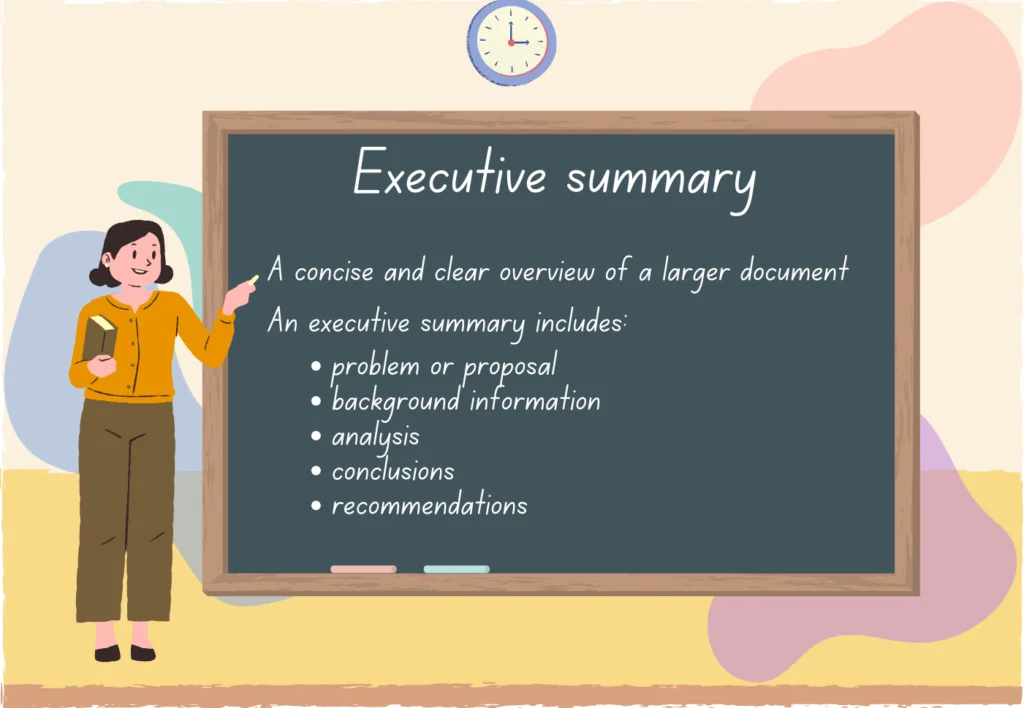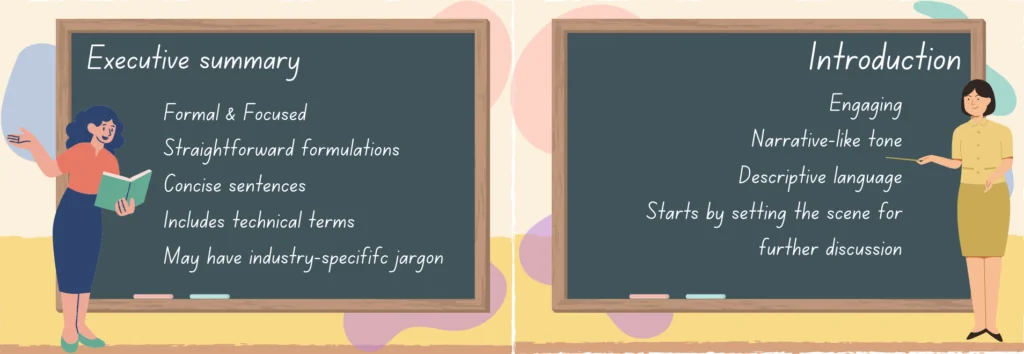We all have at least a slight impression of what a summary is. Now we have another notion to define – an executive summary. There are also people who, when writing, tend to misplace an executive summary and introduction paragraphs. Why, you may ask? Well, for some reason, they find them to be similar. However, we won’t let you make the same mistake. So the first thing you should take from this guide is that the key difference between an executive summary vs introduction is that the first one comprises information from a professional document including just the key points. The second – is just the beginning paragraph of any type of writing.

✅ AI Essay Writer ✅ AI Detector ✅ Plagchecker ✅ Paraphraser
✅ Summarizer ✅ Citation Generator
Executive Summary: Definition, Style, and Characteristics
If you are not a business major, you won’t probably write a lot of executive summaries. But that’s only until you leave university. Because this type of writing is exactly what you will most commonly see being used in the corporate world.

An executive summary is a concise and clear overview of a larger document. It is typically used in business reports and proposals to provide busy executives with a quick snapshot of the main points and conclusions of the work. It is designed to stand alone, allowing readers to understand the main idea of the full document without going into the details.
The style of writing in an executive summary is direct and to the point, with a focus on clarity and briefness. In this type of writing, you will more often than not see bullet points or numbered lists that are called to highlight key information. You will also notice that the summary itself is written in a language that is accessible to the target audience, which can vary from industry experts to general readers. Key characteristics that define an executive summary include:
- its length, which is usually no more than 10% of the main document;
- ability to be read independently;
- and inclusion of all critical elements from the main text, such as the problem or proposal, background information, analysis, conclusions, and recommendations.
Unlike an introduction, which sets the stage for the document, an executive summary provides a quick overview, throwing the most important aspects into the reader right away. And that’s why such a summary becomes a key for quick decision-making and further action.
Executive Summary vs Introduction: Comparison
After reading that definition, you may now see that an executive summary and an introduction have different purposes in a document. An executive summary is a concise overview of the full document, that includes the key points, findings, and recommendations for busy readers. It is typically written in a straightforward, no-frills style and includes all essential information, allowing it to stand alone.
In contrast, an introduction sets the stage for the document, providing background information, context, and the purpose of the writing. It is generally more engaging and written to pique the reader’s interest, leading them to the main body of the document. While an executive summary is written after the main content to capture all critical points, an introduction is written first to introduce the topic and outline what the reader can expect from the document.
| Introduction | Aspect | Executive Summary |
|---|---|---|
| What the document is about and why it’s written | What it Tells You🗣️ | What is covered and its significance |
| To provide background and context | Objective🎯 | To highlight key points for decision-making |
| Short | Length📏 | Comparatively longer |
| First | When is it Written✍️ | Last (after the main content) |
Executive Summary vs Introduction – The Differences in Tone and Language
Tone and language serve a distinct purpose in all types of writing. They help stay professional or keep the reader on the hook of the story. An executive summary is no exception. Typically, as it includes a summary of the business documentation, it is written in a formal and focused tone. The language is straightforward, with an emphasis on clarity and conciseness. It often includes technical terms and industry-specific jargon, as it is usually written for an audience already familiar with the subject matter.

Introductions can be written in a different tone of voice and vocabulary. It depends on where the introduction will further be used. Yet, even in business writing, introduction paragraphs tend to have a more engaging and narrative-like tone. After all, their main purpose is to capture the reader’s interest and provide context for the document. The language is therefore often more descriptive and inviting, intending to ease the reader into the topic. It may start with a broader perspective (to set the scene for the discussion) before narrowing down to the specific subject of the document.
Consider the following example of a business document:
Introduction:
Welcome to our analysis of the current trends in the renewable energy sector. This report discusses the latest advancements, market dynamics, and future prospects of sustainable energy solutions. Our goal is to provide you with a thorough understanding of the opportunities and challenges in this growing and evolving industry.
Executive Summary:
This report offers an analysis of the renewable energy sector, focusing on three key areas: trends, technological innovations, and market movements. It discusses trends in the shift towards decentralization and the increasing demand for clean energy. In terms of technological innovations, the report examines advancements in energy storage solutions and the integration of artificial intelligence in energy management systems. Market movements covered include the rise of green bonds and the impact of global trade policies on renewable energy investments. The report highlights the sector’s significant growth potential, driven by factors such as government support and consumer awareness. Key findings include the rapid adoption of solar and wind energy, the influence of regulatory frameworks on market expansion, and the promising investment opportunities in regions like Asia-Pacific and Africa.
Conclusion
Now you know the difference between an executive summary and an introduction. So you better be ready and prepared to write a couple of them when you join the working lifestyle. Of course, if you won’t be doing a regular 9-5 job then maybe you will be free from creating executive summaries and coming up with introductions. However, the situation with writing this type of (boring) stuff is the same as with being chased by a goose: they are low but never zero.
To better understand the concept of summarizing, you can use our free AI Summarizer. Running some tests will help you put the theory into practice!
FAQ
Follow us on Reddit for more insights and updates.





Comments (0)
Welcome to A*Help comments!
We’re all about debate and discussion at A*Help.
We value the diverse opinions of users, so you may find points of view that you don’t agree with. And that’s cool. However, there are certain things we’re not OK with: attempts to manipulate our data in any way, for example, or the posting of discriminative, offensive, hateful, or disparaging material.